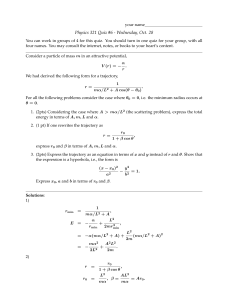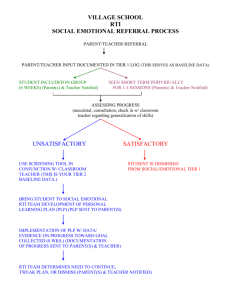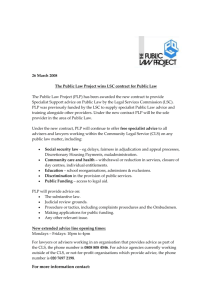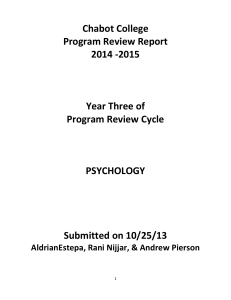A Model for Host-Multipathogen Interaction
advertisement
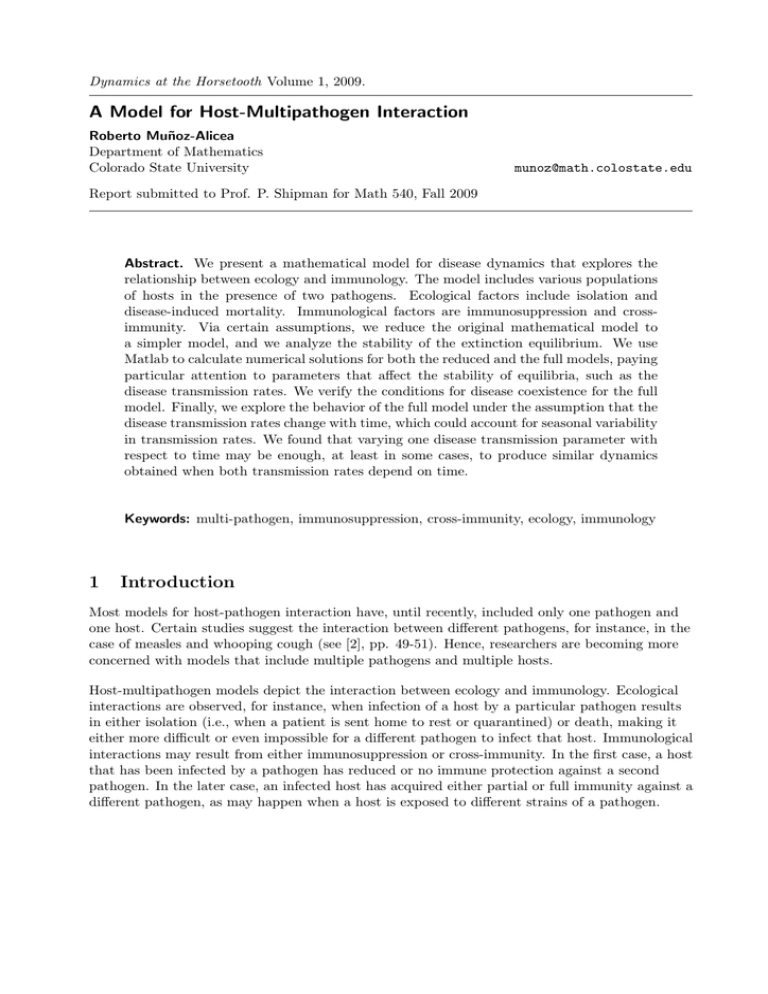
Dynamics at the Horsetooth Volume 1, 2009.
A Model for Host-Multipathogen Interaction
Roberto Muñoz-Alicea
Department of Mathematics
Colorado State University
munoz@math.colostate.edu
Report submitted to Prof. P. Shipman for Math 540, Fall 2009
Abstract. We present a mathematical model for disease dynamics that explores the
relationship between ecology and immunology. The model includes various populations
of hosts in the presence of two pathogens. Ecological factors include isolation and
disease-induced mortality. Immunological factors are immunosuppression and crossimmunity. Via certain assumptions, we reduce the original mathematical model to
a simpler model, and we analyze the stability of the extinction equilibrium. We use
Matlab to calculate numerical solutions for both the reduced and the full models, paying
particular attention to parameters that affect the stability of equilibria, such as the
disease transmission rates. We verify the conditions for disease coexistence for the full
model. Finally, we explore the behavior of the full model under the assumption that the
disease transmission rates change with time, which could account for seasonal variability
in transmission rates. We found that varying one disease transmission parameter with
respect to time may be enough, at least in some cases, to produce similar dynamics
obtained when both transmission rates depend on time.
Keywords: multi-pathogen, immunosuppression, cross-immunity, ecology, immunology
1
Introduction
Most models for host-pathogen interaction have, until recently, included only one pathogen and
one host. Certain studies suggest the interaction between different pathogens, for instance, in the
case of measles and whooping cough (see [2], pp. 49-51). Hence, researchers are becoming more
concerned with models that include multiple pathogens and multiple hosts.
Host-multipathogen models depict the interaction between ecology and immunology. Ecological
interactions are observed, for instance, when infection of a host by a particular pathogen results
in either isolation (i.e., when a patient is sent home to rest or quarantined) or death, making it
either more difficult or even impossible for a different pathogen to infect that host. Immunological
interactions may result from either immunosuppression or cross-immunity. In the first case, a host
that has been infected by a pathogen has reduced or no immune protection against a second
pathogen. In the later case, an infected host has acquired either partial or full immunity against a
different pathogen, as may happen when a host is exposed to different strains of a pathogen.
A Model for Host-Multipathogen Interaction
Roberto Muñoz-Alicea
The host-multipathogen model presented here was originally introduced and discussed by Pejman
Rohani, Helen J. et al (see [2]). In section 2, we present the model assumptions, parameters, and
equations. In section 3, we analyze a reduced version of the model, obtained by assuming that
there is no disease-induced mortality and no immune-mediated interaction. In section 4, we
analyze the full model, mostly through numerical solutions, and verify the conditions for disease
coexistence stated in [2]. In addition, we expand on this analysis by exploring the influence of
seasonal variability of the disease transmission parameters in the model dynamics (see [2], p.65,
where disease transmission rates are assumed to be higher during school terms and lower at other
times of the year).
2
The Model
2.1
Assumptions
The model considers infection by two different pathogens and is based on the following assumptions
(summarized from [2], pp. 53-54).
• All newborns are susceptible to both infections.
• Once an individual becomes infected by a pathogen, the individual leaves the susceptible
population and enters the exposed population for that pathogen. The exposed individual
does not show any symptoms and is not infectious yet, but has entered a latent period of
infection. During this period, the individual may contract the second (“competing”) disease.
• At the end of the latency period, the individual becomes infectious (can transmit the disease
to others), though asymptomatic, and may still become infected with the second pathogen.
• Once symptoms appear, the infected individual enters the convalescent population for the
disease. During convalescence, the individual may be in a period of isolation and either
temporary cross-immunity or temporary immunosuppression. In either case, there is a
probability of contracting the second disease. In addition, the convalescing individual may
eventually die or may recover from the disease.
• An individual that has recovered from infection by a particular pathogen is assumed to be
immune to that pathogen but may still be susceptible to the second pathogen, if not previously
exposed to it.
2.2
Populations
The following are the variables used in the model. The subscript i = 1, 2 is used to distinguish
between the two diseases (see [2], p.64).
• S0 = individuals susceptible to both diseases
• Ei = individuals exposed to disease i only
• Ii = infectious individuals with disease i only
• Ci = convalescing individuals with disease i only
Dynamics at the Horsetooth
2
Vol. 1, 2009
A Model for Host-Multipathogen Interaction
Roberto Muñoz-Alicea
• Si = individuals who have recovered from disease i only
• S12 = individuals who are no longer susceptible to either infection; they have been exposed
in some way to both infections
• εi = individuals exposed to disease i
•
λi
βi
= infectious individuals with disease i
Note that the last two types of populations overlap with the previous ones, as they may include
individuals who have been infected by both pathogens. We also have
• N = S0 + S12 +
2
X
(Ei + Ii + Ci + Si ) = total population
i=1
2.3
Parameters
The parameters that appear in the model are the following (as before, i = 1, 2; see [2], p.64):
• v = host per capita birth rate (0-1 1/year)
• µ = host per capita death rate (0-1 1/year)
• βi = transmission rate of disease i (typically 100-2,000 1/year)
• 1/σi = latency period of disease i (typically 1/52-2/52 years)
• 1/γi = infectious period of disease i (typically 1/52-3/52 years)
• 1/δi = isolation period of disease i (typically 1/52-4/52 years)
• ρi = probability of infection-induced mortality for disease i (0-1)
• φi = coinfection probability of disease i, after contracting disease j 6= i (0-1)
• ξi = temporary immunosuppression or cross-immunity for disease i, after contracting disease
j 6= i (≥ 0)
• χi = permanent immunosuppression or cross-immunity for disease i, after contracting disease
j 6= i (≥ 0)
• ψi = differential infection-induced mortality for disease i (0-1)
Dynamics at the Horsetooth
3
Vol. 1, 2009
A Model for Host-Multipathogen Interaction
2.4
Roberto Muñoz-Alicea
Equations
The host-multipathogen model is a system of 14 ordinary differential equations defined as follows
(see [2], p.63):
dS0
S0
= υN − (λ1 + λ2 ) − µS0
(1)
dt
N
dE1
S0
E1
= λ1
− φ2 λ2
− (σ1 + µ)E1
dt
N
N
(2)
dE2
S0
E2
= λ2
− φ1 λ1
− (σ2 + µ)E2
dt
N
N
(3)
dI1
I1
= σ1 E1 − φ2 λ2 − (γ1 + µ)I1
dt
N
(4)
I2
dI2
= σ2 E2 − φ1 λ1 − (γ2 + µ)I2
dt
N
(5)
dC1
C1
= γ1 I1 − ξ2 φ2 λ2
− (δ1 + µ)C1
dt
N
(6)
C2
dC2
= γ2 I2 − ξ1 φ1 λ1
− (δ2 + µ)C2
dt
N
(7)
dS1
S1
= (1 − ρ1 )δ1 C1 − χ2 λ2
− µS1
dt
N
(8)
dS2
S2
= (1 − ρ2 )δ2 C2 − χ1 λ1
− µS2
dt
N
µ
¶
dS12
φ2 E1 + φ2 I1 + ξ2 φ2 C1
φ1 E2 + φ1 I2 + ξ1 φ1 C2
= (1 − ρ1 )(1 − ρ2 ) λ2
+ λ1
dt
N
N
+(1 − ψ2 ρ2 )χ2 λ2
S2
S1
+ (1 − ψ1 ρ1 )χ1 λ1
− µS12
N
N
(9)
(10)
dε1
S0
E2
I2
C2
S2
= λ1
+ φ1 λ1
+ φ1 λ1 + ξ1 φ1 λ1
+ χ1 λ1
− (σ1 + µ)ε1
dt
N
N
N
N
N
(11)
dε2
S0
E1
I1
C1
S1
= λ2
+ φ2 λ2
+ φ2 λ2 + ξ2 φ2 λ2
+ χ2 λ2
− (σ2 + µ)ε2
dt
N
N
N
N
N
(12)
dλ1
= β1 σ1 ε1 − (γ1 + µ)λ1
dt
(13)
dλ2
= β2 σ2 ε2 − (γ2 + µ)λ2
dt
(14)
Dynamics at the Horsetooth
4
Vol. 1, 2009
A Model for Host-Multipathogen Interaction
Roberto Muñoz-Alicea
Figure 1: Flow Diagram for the Host-Multipathogen Model
We summarize the flow along the non-overlapping populations of the model in Figure 1. We
include the parameters associated with each transition. Notice that an individual follows a
vertical path of populations, on either the left side or right side of the diagram, while he or she is
only infected with one pathogen. The moment an individual becomes exposed to both infections,
even if they have recovered from the first infection, he or she transitions into the S12 population.
Individuals in the S12 population may have recovered from both diseases, or may still be exposed
or infectious with one or both diseases (see [2], p. 64). Thus, S12 individuals may be included in
the ε1 , ε2 , λ1 , or λ2 populations, continuing to play a role in disease transmission.
In addition to the flow depicted in Figure 1, newborn individuals enter the susceptible population
S0 only, and anyone may die from either natural death or from infection-induced death.
3
The Reduced Model
If we let Zi = Ei + Ii + Ci + Si + S0 (i = 1, 2), and assume that there is no disease-induced
mortality (ρ1 = ρ2 = 0), no immunosuppression/cross-immunity (ξi = χi = 1, i = 1, 2), and that
the probability of coinfection is 1 (φi = 1, i = 1, 2), we can reduce the original host-multipathogen
model to obtain the following model (see [2], pp. 64-65).
3.1
Equations
Dynamics at the Horsetooth
dS0
S0
= υN − (λ1 + λ2 ) − µS0
dt
N
(15)
dZ1
Z1
= υN − λ2
− µZ1
dt
N
(16)
Z2
dZ2
= υN − λ1
− µZ2
dt
N
(17)
5
Vol. 1, 2009
A Model for Host-Multipathogen Interaction
3.2
Roberto Muñoz-Alicea
dS12
Z1 − S0
Z2 − S0
= λ2
+ λ1
− µS12
dt
N
N
(18)
dε1
Z2
= λ1
− (σ1 + µ)ε1
dt
N
(19)
dε2
Z1
= λ2
− (σ2 + µ)ε2
dt
N
(20)
dλ1
= β1 σ1 ε1 − (γ1 + µ)λ1
dt
(21)
dλ2
= β2 σ2 ε2 − (γ2 + µ)λ2
dt
(22)
Analysis
We perform a brief analysis of the reduced system of equations by seeking an equilibrium of the
form N = S0 , that is, a disease-free equilibrium. First, we notice that N = Z1 + Z2 − S0 + S12 . If
we require also that Z1 = Z2 = N = S0 , then N = S0 + S12 ⇒ S12 = 0. Solving for the equilibria
of this system we obtain
from equation 15: 0 = (υ − µ)S0 − (λ1 + λ2 ) ⇒ S0 =
λ1 +λ2
υ−µ ,
from equation 16: 0 = (υ − µ)S0 − λ2 ⇒ λ2 = (υ − µ)S0 = λ1 + λ2 ⇒ λ1 = 0 ⇒ S0 =
λ2
υ−µ ,
from equation 17: 0 = (υ − µ)S0 − λ1 ⇒ λ1 = (υ − µ)S0 ⇒ λ2 = 0 ⇒ S0 = 0.
From the last four equations, we see that the above results imply that ε1 = ε2 = 0. Hence, the
equilibrium obtained is the trivial (extinction) equilibrium.
With the above assumptions, we have two decoupled systems: (Z1 , ε2 , λ2 ) and (Z2 , ε1 , λ1 ). Let us
look at (Z1 , ε2 , λ2 ). The equations can be written as
dZ1
= (υ − µ)Z1 − λ2
dt
(23)
dε2
= λ2 − (σ2 + µ)ε2
dt
(24)
dλ2
= β2 σ2 ε2 − (γ2 + µ)λ2
dt
(25)
The Jacobian matrix for this system is
υ−µ
0
−1
,
0
−(σ2 + µ)
1
0
β2 σ2
−(γ2 + µ)
which has eigenvalues
Dynamics at the Horsetooth
6
Vol. 1, 2009
A Model for Host-Multipathogen Interaction
Roberto Muñoz-Alicea
η1 = υ − µ,
p
η2 = 12 (−2µ − γ2 − σ2 − (γ2 − σ2 )2 + 4β2 σ2 ),
p
η3 = 21 (−2µ − γ2 − σ2 + (γ2 − σ2 )2 + 4β2 σ2 ).
The (hyperbolic) equilibrium is stable if all eigenvalues of the Jacobian matrix are negative (see
[3], Chapter 1 and sections 2.6-2.8). That is, the equilibrium is stable if υ − µ < 0 and
p
−2µ − γ2 − σ2 + (γ2 − σ2 )2 + 4β2 σ2 < 0
p
⇔ (γ2 − σ2 )2 + 4β2 σ2 < 2µ + γ2 + σ2
⇔ (γ2 − σ2 )2 + 4β2 σ2 < (2µ + γ2 + σ2 )2
⇔ γ22 − 2γ2 σ2 + σ22 + 4β2 σ2 < 4µ2 + 4µγ2 + 4µσ2 + γ22 + 2γ2 σ2 + σ22
⇔ 4β2 σ2 < 4γ2 σ2 + 4µ2 + 4µγ2 + 4µσ2
⇔
β2 σ2
γ2 σ2 +µ2 +µγ2 +µσ2
⇔ R02 =
β2 σ2
(µ+σ2 )(µ+γ2 )
<1
< 1.
The quantity R0i is defined to be the basic reproductive ratio for disease i (see [2], p.54). R0i can
be interpreted as the average number of secondary infections produced by introducing a single
infected individual with disease i into a population of susceptibles (see [1], p. 247).
3.3
Numerical Solutions
We use Matlab’s ode23 function to calculate numerical solutions to the reduced model. The goal
is to verify the conditions for stability of the trivial equilibrium and explore the different possible
behaviors of the model according to the value of R02 . Initial values used are Z1 (0) = 50, 000, ε2 (0) =
10, λ2 (0) = 0.
Figure 2: υ = 0.01, µ = 0.02, σ2 = 45.625, γ2 = 95, β2 = 70; R02 = 0.7364
Figure 2 shows an example were the trivial equilibrium is stable. Notice that R02 < 1 and
υ − µ < 0. Susceptible, exposed, and infectious individuals decrease to zero as time increases.
Dynamics at the Horsetooth
7
Vol. 1, 2009
A Model for Host-Multipathogen Interaction
Roberto Muñoz-Alicea
Figure 3: υ = 0.09, µ = 0.02, σ2 = 45.625, γ2 = 95, β2 = 70, R02 = 0.7364
In Figure 3 we see an example where the trivial equilibrium is unstable. Susceptible individuals
increase with time, while the exposed and infectious populations go to zero. In this case R02 < 1
but υ − µ > 0.
In Figures 4 and 5 the value of R02 > 1, and hence the populations of exposed and infectious
individuals increase.
Figure 4: υ = 0.01, µ = 0.02, σ2 = 45.625, γ2 = 90, β2 = 100, R02 = 1.1104
In Figure 5 we see that the population of susceptible individuals increases for a while and then
begins to decrease towards zero. The results observed here suggest that the increase in the
population of susceptible individuals will occur, at least for some time, whenever υ − µ > 0.
Dynamics at the Horsetooth
8
Vol. 1, 2009
A Model for Host-Multipathogen Interaction
Roberto Muñoz-Alicea
Figure 5: υ = 0.09, µ = 0.02, σ2 = 45.625, γ2 = 90, β2 = 100, R02 = 1.1104
4
4.1
The Full Model
Stability
According to Pejman Rohani, Helen J. et al ([2], p. 54), the disease coexistence state requires
Ri
R0i > 1 and R0j > 1+a (R0i −1) , where
i
0
ai =
and R0i =
4.2
βi σi
(µ+σi )(µ+γi ) , i, j
1
σi +µ {φµ
+
σi
γi +µ (φµ
+
γi
δi +µ (ξφµ
+ χ(1 − ρi )δi ))}
= 1, 2, j 6= i.
Numerical Solutions
The following parameter values, based on values provided by Pejman Rohani, Helen J. et al [2]
in the study of measles (i = 1) and whooping cough (i = 2), were used for the calculation
of numerical solutions: µ = 0.02, σ1 = σ2 = 45.625, δ1 = 365/7, δ2 = 365/14, γ1 = 73, γ2 =
365/14, β1 = 1250, β2 = 446. In addition, the last two parameters were varied in order to
explore bifurcations, that is, the change in stability of the disease coexistence state. Other
parameter values used are provided with each of the following figures. Initial values used were
S0 (0) = 50, 000, Ei (0) = 10, Ii (0) = Ci (0) = Si (0) = S12 (0) = 0, εi (0) = λi (0) = 0.2, i = 1, 2.
In Figure 6, we see that the populations for both diseases increase with time, which is consistent
with the fact that the conditions for disesase coexistence are satisfied. Also, if we look closer at
the behavior of the populations (for instance, the exposed individuals), we notice that the
infections run mostly out-of-phase.
Figure 7 depicts a similar situation, except that the coinfection parameters were set to 1. The
graph suggests that both diseases will run more in-phase with each other for larger coinfection
probabilities.
Dynamics at the Horsetooth
9
Vol. 1, 2009
A Model for Host-Multipathogen Interaction
Roberto Muñoz-Alicea
Figure 6: υ = 0.09, φi = 0.06, ξi = 2, ρi = 0.1, χi = 4.7, ψi = 0.2, R01 = 17.1111, R02 =
17.0862, 1+a
R02
2
2 (R0 −1)
= 0.2479, 1+a
R01
1
1 (R0 −1)
= 0.2477.
Figure 7: υ = 0.09, φi = 1, ξi = 2, ρi = 0.1, χi = 4.7, ψi = 0.2, R01 = 17.1111, R02 =
17.0862, 1+a
R02
2
2 (R0 −1)
= 0.2478, 1+a
R01
1
1 (R0 −1)
= 0.2476.
Figure 8 suggests that having at least one low probability of coinfection brings back the
out-of-phase behavior for the infections. This result seems to imply that the real life coinfection
probabilities for measles and/or whooping cough are low, since these two diseases tend to run
out-of-phase (see [2], pp. 51-52).
Dynamics at the Horsetooth
10
Vol. 1, 2009
A Model for Host-Multipathogen Interaction
Roberto Muñoz-Alicea
Figure 8: υ = 0.09, φ1 = 0.06, φ2 = 1, ξi = 2, ρi = 0.1, χi = 4.7, ψi = 0.2, R01 = 17.1111, R02 =
17.0862, 1+a
R02
2
2 (R0 −1)
= 0.2478, 1+a
R01
1
1 (R0 −1)
= 0.2477.
In Figure 9 we see a case where there is strong permanent croos-immunity for the two infections.
The figure depicts an interesting situation, where, during the first few years, one of the diseases is
clearly dominant over the competing disease for certain periods of time. The out-of-phase
behavior is quite pronounced as well.
Figure 9: υ = 0.09, φi = 0.06, ξi = 2, ρi = 0.1, χi = 0.1, ψi = 0.2, R01 = 17.1111, R02 =
17.0862, 1+a
R02
2
2 (R0 −1)
= 6.9810, 1+a
R01
1
1 (R0 −1)
= 6.9846.
The next figures represent cases where the disease coexistence conditions are not satisfied.
In Figure 10 we see a case where the disease transmission rates are low. The values of R0i are
both greater than 1, and R02 >
Dynamics at the Horsetooth
R01
,
1+a1 (R01 −1)
but R01 <
11
R02
.
1+a2 (R02 −1)
Vol. 1, 2009
A Model for Host-Multipathogen Interaction
Roberto Muñoz-Alicea
Figure 10: υ = 0.09, φi = 0.06, ξi = 2, ρi = 0.1, χi = 0.1, ψi = 0.2, β1 = 100, β2 = 200, R01 =
1.3689, R02 = 7.6620, 1+a
R02
2
2 (R0 −1)
R01
1
1 (R0 −1)
= 4.7903, 1+a
= 1.3249.
For Figure 11, the values of R0i are still both greater than 1, R01 >
R02 <
R01
1+a1 (R01 −1)
R02
,
1+a2 (R02 −1)
but
. We notice in the last two cases that the population of infected individuals that
remains seems to be determined by the value of R0j that is greater than
R0i
,j
1+ai (R0i −1)
6= i.
Figure 11: υ = 0.09, φi = 0.06, ξi = 2, ρi = 0.1, χi = 0.1, ψi = 0.2, β1 = 180, β2 = 50, R01 =
2.4640, R02 = 1.9155, 1+a
R02
2
2 (R0 −1)
Dynamics at the Horsetooth
R01
1
1 (R0 −1)
= 1.7697, 1+a
12
= 2.1772.
Vol. 1, 2009
A Model for Host-Multipathogen Interaction
Roberto Muñoz-Alicea
For the case in Figure 12, the disease transmission rates were set very low. Here R02 > 1, but
R01 < 1.
Figure 12: υ = 0.09, φi = 0.06, ξi = 2, ρi = 0.1, χi = 0.1, ψi = 0.2, βi = 30, R01 = 0.4107, R02 =
1.1493, 1+a
R02
2
2 (R0 −1)
R01
1
1 (R0 −1)
= 1.1341, 1+a
= 0.4337.
The case depicted by Figure 13 is very similar to that of Figure 12, except that now R02 < 1, and
R01 > 1. These last two cases suggest that the value of R0i that is greater than one will determine
which of the two diseases will remain.
Figure 13: υ = 0.09, φi = 0.06, ξi = 2, ρi = 0.1, χi = 0.1, ψi = 0.2, β1 = 100, β2 = 30, R01 =
1.3689, R02 = 0.7662, 1+a
R02
2
2 (R0 −1)
Dynamics at the Horsetooth
R01
1
1 (R0 −1)
= 0.7827, 1+a
13
= 1.3249.
Vol. 1, 2009
A Model for Host-Multipathogen Interaction
Roberto Muñoz-Alicea
Figure 14 shows a disease-free state, where the populations of all exposed, infectious, and
convalescent individuals decrease to zero. Here we have R01 < 1 and R02 < 1. This case helps verify
that when the basic reproductive number for a disease is less than one, the number of individuals
infected with that disease will decrease to zero.
Figure 14: υ = 0.09, φi = 0.06, ξi = 2, ρi = 0.1, χi = 0.1, ψi = 0.2, β1 = 60, β2 = 20, R01 =
0.8213, R02 = 0.7662, 1+a
R02
2
2 (R0 −1)
R01
1
1 (R0 −1)
= 0.7827, 1+a
= 0.8348.
Next, we experiment with the disease transmission rate parameters βi by making them vary with
time, in order to simulate seasonality effects in disease transmission. First, we let
β1 = 1250 + 1000 sin(2πt) and keep β2 = 446. All of the other parameter values were taken the
same as in the case shown in Figure 6. In that case, both diseases coexisted, but the infectious
populations were both increasing. In this case, the infections run markedly out-of-phase and with
sharp spikes in the numbers of infectious individuals. In time, both populations are increasing on
average, but the diseases alternate between each other. The first half of the year belongs to
disease 1, and the second half belongs to disease 2.
Figure 15: υ = 0.09, φi = 1, ξi = 2, ρi = 0.1, χi = 4.7, ψi = 0.2, β1 = 1250 + 1000 sin(2πt), β2 = 446.
Dynamics at the Horsetooth
14
Vol. 1, 2009
A Model for Host-Multipathogen Interaction
Roberto Muñoz-Alicea
Now, we let β1 = 1250 and β2 = 446 + 400 sin(2πt), and keep all other parameters the same as in
the previous case. We observe on Figure 16 that the populations still increase and decrease
sharply each year, with now disease 2 dominating most of the year, but with both diseases
running almost identically for roughly the second half of the year. Contrary to the previous case,
the diseases do not run separately, but towards the middle of each year they both have high
numbers of infectious individuals.
Figure 16: υ = 0.09, φi = 1, ξi = 2, ρi = 0.1, χi = 4.7, ψi = 0.2, β1 = 1250, β2 = 446 + 400 sin(2πt).
Lastly, we let β1 = 1250 + 1000 sin(2πt) and β2 = 446 + 400 sin(2πt), so the transmission rates for
both diseases are now affected by seasonality, and we keep all other parameters the same as
before. We observe that Figure 17 is extremely similar to Figure 15, indicating that, at least in
some situations, it may be enough to have only one of the transmission rates be affected by
seasonal effects in order to produce similar results to those obtained when both transmission rates
depend on seasonal effects.
Figure 17: υ = 0.09, φi = 1, ξi = 2, ρi = 0.1, χi = 4.7, ψi = 0.2, β1 = 1250 + 1000 sin(2πt), β2 =
446 + 400 sin(2πt).
Dynamics at the Horsetooth
15
Vol. 1, 2009
A Model for Host-Multipathogen Interaction
5
Roberto Muñoz-Alicea
Summary
We have considered and performed analysis on a model for host-multipathogen interactions that
takes into account two competing pathogens and populations of susceptibles, exposed, infectious,
convalescing, and recovered individuals for each disease.
The model can be reduced by removing all ecological and immune interactions between the two
pathogens. We analyzed the trivial (extinction) equilibrium for the reduced model. The
conditions for stability of the trivial equilibrium were determined and corroborated through
numerical solutions. We verified that the condition on the basic reproductive number for the
reduced model agrees with the corresponding condition for the full model.
Analysis of the full model was performed via numerical solutions. We verified the conditions for
disease coexistence stated in [2] and varied parameters such as the coinfection probabilities, the
immunosuppression/cross-immunity, and disease transmission rates, among others that affect the
stability of the disease coexistence state.
Among the main findings, we have that lower coinfection probabilities will produce more
out-of-phase behavior between the two diseases (see Figures 6, 7, and 8). In other words, once the
first disease has established itself in the population, there will be very little chance, at least for
some time, for the second disease to spread. Since measles and whooping cough run mostly
out-of-phase from each other, we believe that the coinfection probabilities for at least one of these
two diseases is low. Similar dynamics were observed in the case where there was strong
cross-immunity (which affects individuals who have recovered from at least one of the diseases)
for both diseases, except that the out-of-phase behavior was much more pronounced for the first
few years of infection (see Figure 9).
Figures 10 and 11 suggest that the value of R0j that is greater than
R0i
,j
1+ai (R0i −1)
6= i determines
which of the two diseases will remain in the population, given that both values of R0i are greater
than 1. On the other hand, we see in Figures 12 through 13 that, if at least one of the R0i s is less
than 1, the disease that will remain is the one whose basic reproductive ratio is greater than 1.
Figure 14 shows that when both R0i s are less than 1, the populations of infected individuals for
both diseases will decrease to zero, and the dynamics reach a disease-free state.
Finally, we considered seasonal effects in the disease transmission rates. We used a sine function
to let each disease transmission rate parameter vary with time. First, we let each parameter vary
individually (Figures 15 and 16), then we let both vary together (Figure 17). In all cases, the
dynamics depicted annual sharp increase and decline in the number of infectious individuals for
both diseases. The results also led us to the conjecture that, at least in some cases, seasonal
effects on the transmission rate of one disease may be enough to produce similar outcomes to
those obtained when both transmission rates depend on seasonal factors.
6
Future Work
In order to further the analysis of the reduced model, a different steady state may be sought by
making a weaker assumption than Z1 = Z2 = N = S0 . More simulations should be performed on
both the reduced and full model to further explore the effects of the parameters on the stability of
equilibria, i.e., to perform a more thorough bifurcation analysis. A computer package, such as
Mathematica or Maple, along with appropriate hardware, should be used to attempt to find and
Dynamics at the Horsetooth
16
Vol. 1, 2009
A Model for Host-Multipathogen Interaction
Roberto Muñoz-Alicea
analyze the remaining equilibria for both models. In addition, seasonal variability of disease
transmission rates should be explored further in order to determine conditions where time
dependence of one disease transmission parameter produces similar results to those obtained
when both disease transmission parameters are dependent on time.
Dynamics at the Horsetooth
17
Vol. 1, 2009
A Model for Host-Multipathogen Interaction
7
Roberto Muñoz-Alicea
References
[1] Edelstein - Keshet, L. Mathematical Models in Biology. McGraw-Hill, 1988.
[2] Pejman Rohani, H. J., Wearing, D.A., and Yunxin Huang. ‘Understanding Host-Multipathogen
Systems: Modeling the Interaction Between Ecology and Immunology’. From Chapter Three of
Ostfeld, R.S., Keesing, F., and Eviner, V.T. Infectious Disease Ecology. Princeton University Press,
2008.
[3] Perko, L. Differential Equations and Dynamical Systems. 2nd ed. Springer, 1996.
Dynamics at the Horsetooth
18
Vol. 1, 2009
